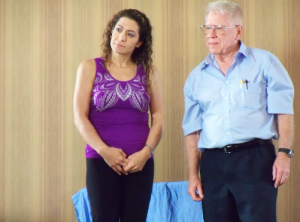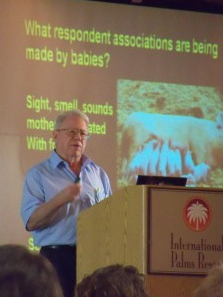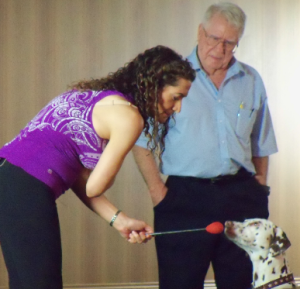
Bob Bailey & Parvene Farhoody
Animals are always learning. The animals we know today are the fruit of millions of years of evolution and have been learning by consequence all this time. They continuously put things together, draw conclusions and figure out how to avoid predators, find mates, shelter and food. Animals (humans included of course) are born learners and as they interact with the world, they try to make sense of it, to sort out what to avoid and what to get, what feels good and what doesn’t. That’s how they stay alive! Learning happens all the time, all over the world, no matter how tiny or large the species. Learning happens even with no trainer in sight. I just came back from a great seminar in Florida that Bob Bailey with former student and trainer Parvene Farhoody gave to a packed crowd of dog lovers, from professionals to passionate owners. Bailey and Farhoody made it very clear, that, as trainers, we need to pay better attention to what we do, to how we do it and to what behaviors we reinforce or punish. ‘You get what you reinforce, not what you want!’
‘Behavior is lawful’ (Ogden Lindsley), in other words, behavior follows laws. Thanks to the advances in scientific studies of behavior, from Darwin and Wallace, Pavlov, Skinner, Tinbergen and Lorenz, and to all of those who have followed, today, we can measure, predict, analyze and quantify behavior. We’re far from understanding all that animals do, but one thing that we do know is that animals behave to ‘get good things and avoid bad things!’ But understanding and manipulating behavior in a lab, with animals that have nothing else to do but press levers and buttons to get food or avoid electric shocks, is very different than working with animals out in the field. Dolphins can find live fish on their own when they’re swimming in the ocean, so why would they work for hours for nothing but dead fish from a bucket? Birds can fly away, looking for social partners or food when the trainer has nothing to offer but a small piece of meat. Dogs will often prefer chasing after a squirrel or a ball, smell a patch of grass or play with another dog over training with their human.
 Merging science with animal training, or in other words, applied behavior analysis, requires a keen understanding of the principles at play as well as systems and procedures in place. More than anybody else, Bob Bailey has mastered the science of animal training. Over the course of his life, Bailey has worked with thousands of animals of all species, training them to very highest levels of fluency. From dolphins to cats, bears, parrots, raven, goats, pigs, raccoons, rabbits, ducks, dogs, chicken and more… Bailey is methodic, precise and constantly looking for ways to make training the most efficient possible. Through his years of working with ABE, Bailey developed impeccable technique and has become a force to learn from for anyone who strives to become the best trainer they can be. His Wiz-Bang training as he calls it defines training to the very highest levels ever achieved with dolphins swimming for miles at sea, looking for mines, birds scanning or taking pictures from the air or dogs working with their handlers through difficult and sometimes dangerous circumstances. There are situations, where ‘good enough’, just isn’t ‘good enough’.
Merging science with animal training, or in other words, applied behavior analysis, requires a keen understanding of the principles at play as well as systems and procedures in place. More than anybody else, Bob Bailey has mastered the science of animal training. Over the course of his life, Bailey has worked with thousands of animals of all species, training them to very highest levels of fluency. From dolphins to cats, bears, parrots, raven, goats, pigs, raccoons, rabbits, ducks, dogs, chicken and more… Bailey is methodic, precise and constantly looking for ways to make training the most efficient possible. Through his years of working with ABE, Bailey developed impeccable technique and has become a force to learn from for anyone who strives to become the best trainer they can be. His Wiz-Bang training as he calls it defines training to the very highest levels ever achieved with dolphins swimming for miles at sea, looking for mines, birds scanning or taking pictures from the air or dogs working with their handlers through difficult and sometimes dangerous circumstances. There are situations, where ‘good enough’, just isn’t ‘good enough’.
So what distinguishes a great trainer from a good trainer or a so-so trainer? A great trainer knows how to get the behavior as quickly as possible and as accurately as possible with the least chances of extinction. The best trainers focus on building behaviors, building the desired habits, not suppressing the behaviors that we don’t want. When we reinforce behaviors, the variability diminishes. The animal is less likely to do other behaviors than the ones that lead to a positive outcome. When our focus is on stopping unwanted behavior, the consequence is more variability. Telling an animal what not to do is not teaching it what to do. Punishment also has the pitfall of generalizing very quickly, which can result in more problems down the road. For Bailey, the best results are only achievable through scientific applications of learning principles and positive reinforcement.
As Bob Bailey and Parvene Farhoody have pointed out: during training sessions, many trainers accidentally also reinforce what is NOT wanted, have poor timing and don’t set clear criteria. If that’s true, why do we still get good results? Let me answer that question with another question that Bailey asked. Would we feel the same about our training if we weren’t working with dogs, but with grizzly bears? If we were working with an animal that could kill us, wouldn’t we do our best to avoid confusing it, frustrating it or inadvertently teaching it that growling for instance gets us to ask it for a ‘sit’ then give it a treat? Most professional trainers are good trainers and have a good understanding of dog behavior and training techniques. But let’s face it; dogs are a very forgiving species. Through our inconsistencies, confusing body signals, poor timing, stingy reinforcement rates, constant talking and moving, changes in tones of voice, etc., our dogs are still capable of figuring out what’s the best way to get the treat.
Our biggest problem: we tend to settle for ‘good enough’. When a dog lies down on cue for us, in most places with a fair amount of distractions, that’s good enough and we tend to move on to the next behavior. What if our criteria was for the dog to go down as fast as it could possibly get in position, adopt a perfect sphinx position, no matter where he is or what is happening around him, and regardless of who’s holding the leash and asking for the cue. Training to the level of fluency requires lots and lots of repetition and rewarding only those behaviors that we want and at the criteria we have defined. It can be boring and demanding for the trainer, but it’s the only way to get great results.
 If we’re just wanting to have fun with our dog and teaching him basic manners and a few tricks is all we’re looking for, having a good time with our pet is really what counts most. If however, we train dogs professionally, either pet dogs or working dogs, Bailey and Farhoody bring forth the idea of paying more attention to what we’re really teaching our dogs. Are we teaching our dog to lag, by rewarding her even though she was 1 foot behind us? Just because the dog is close enough to the target behavior, doesn’t mean that we should reward that behavior. What we reward is what we’ll get more of, emphasized Farhoody, it’s the matching law: the more a behavior is reinforced, the stronger it gets. Every time we reinforce so-so behavior, that’s what we’ll get more of.
If we’re just wanting to have fun with our dog and teaching him basic manners and a few tricks is all we’re looking for, having a good time with our pet is really what counts most. If however, we train dogs professionally, either pet dogs or working dogs, Bailey and Farhoody bring forth the idea of paying more attention to what we’re really teaching our dogs. Are we teaching our dog to lag, by rewarding her even though she was 1 foot behind us? Just because the dog is close enough to the target behavior, doesn’t mean that we should reward that behavior. What we reward is what we’ll get more of, emphasized Farhoody, it’s the matching law: the more a behavior is reinforced, the stronger it gets. Every time we reinforce so-so behavior, that’s what we’ll get more of.
As Bailey points out: ‘training is a mechanical skill. Many trainers make costly training mistakes that slow down the training, teach the dogs chains of behavior or confuse and discourage the dog altogether. It’s important to respond to the dog that’s in front of us and be willing to adjust our position accordingly’. It’s also really important to practice our skills, just like a musician would practice scales over and over. Getting great at delivering treats quickly and accurately for instance, will contribute to better and cleaner training.
With operant conditioning and classical conditioning always at play, our biggest task as trainers is to ‘make it easy and worthwhile for the animal to make the choice we want.’ The more we view training as applied science, taking notes and collecting data, objectively watching the dog, and ourselves through video taping, the better we can become. Never forgetting that the dog is always learning, always making associations between events, we can also pay more attention to what he is really learning. Objective description of our training sessions will help us recognize what behavior is reinforced and quickly modify the situation if needed. For the sake of the dogs, the clearer we are, the easier it is for them. If our goal is to get better at working with dogs, we need to stand on the shoulders of giants, stay humble and open-minded. Just like animals that are constantly learning, let’s do the same, and up our game!
Jennifer Cattet Ph.D.
Related articles







Thank you Jennifer. Just the post I needed to link to in a blog post I am writing! Your timing is impeccable.
Masterly said and great article. I am upset at not being able to make this seminar. But I will in the future!
Russell Hartstein Fun Paw Care
Thanks for posting this Jennifer. I so wanted to attend this but wasn’t able to. Sounds like it was totally awesome.
I have attended Bob Bailey’s Chicken Camps and can say without hesitation it has forever changed my view of what is possible with training. As Bob often says “believe”..believe in the science and believe in yourself and amazing things can happen. If you ever get a chance to attend any workshop by Bob, do it!
I was at the seminar and I agree, it was really thought provoking and taught us so much about how to be better trainers using solid scientific knowledge of how dogs think and learn and the years of experience by the seminar leaders. Kudos to Bailey and Farhoody!